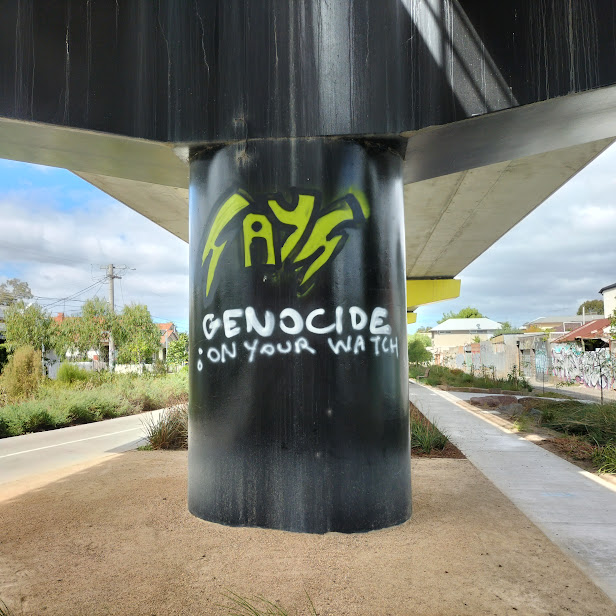Does this wall support the political statements it is making? And the more radical question: is this wall for or against people?
I thought of this question last night at the Collingwood Yards after the book launch of Sabina Andron’s Urban Surfaces, Graffiti and the Right to the City. At the launch, Andron tried to get people to think of questions to ask about a wall in the city.
As I left, I stopped at the wall to photograph a poster advertising her book. Someone had written “Free Palestine” in some white space on the poster. It was only then that I thought of my questions.
Not all walls are supporting, but almost all exterior walls are load-bearing. Walls support paint, graffiti, posters, and other materials that accumulate on their surface, just as canvas, wood, or paper might support other art.
Walls are used to exclude—who is in and out. Politically significant walls of separation, the Berlin Wall and Israel’s illegal wall in the occupied West Bank, are also famous sites for graffiti. The graffiti on these authoritarian walls points out that the more the wall is used to exclude, the less control there is of the other side. Ultimately, with both these walls, the wall builders created a surface that supported their opponent. This irony adds more quality to the work on these walls.
This is also true of graffiti on rail systems’ rolling stock and infrastructure. Melbourne’s public transport does not officially support graffiti; it works hard to prevent it, but it has provided many supports for it. Trains and the concrete sides of train tracks have been traditional supports for graffiti. Now, the pillars of the elevated railway tracks are used as surfaces for the urgent messages of radical graffiti and tagging. “Stolen Land”, “Genocide on your watch”, “Free Palestine”
State Premier Jacinta Allan would disagree with messages sprayed on the pillars, but she gave the city these new surfaces. The regular buffing of the pillars doesn’t discourage determined people from spreading a message to the hundreds of people who use the path for walking or cycling. The buffing discourages serious graffiti writers and street artists who don’t want their hard work removed, so none of the quality work associated with Melbourne’s street art exists on either side of the rail corridor pathway.
This is not a book review; I’ve only started reading Andron’s book. In chapter one, she is still laying the groundwork, explaining the semiotics of the city and how her approach differs in that she reads the signs rather than reading the space as a sign… Still, her idea of interrogating walls in the city is inspiring.








